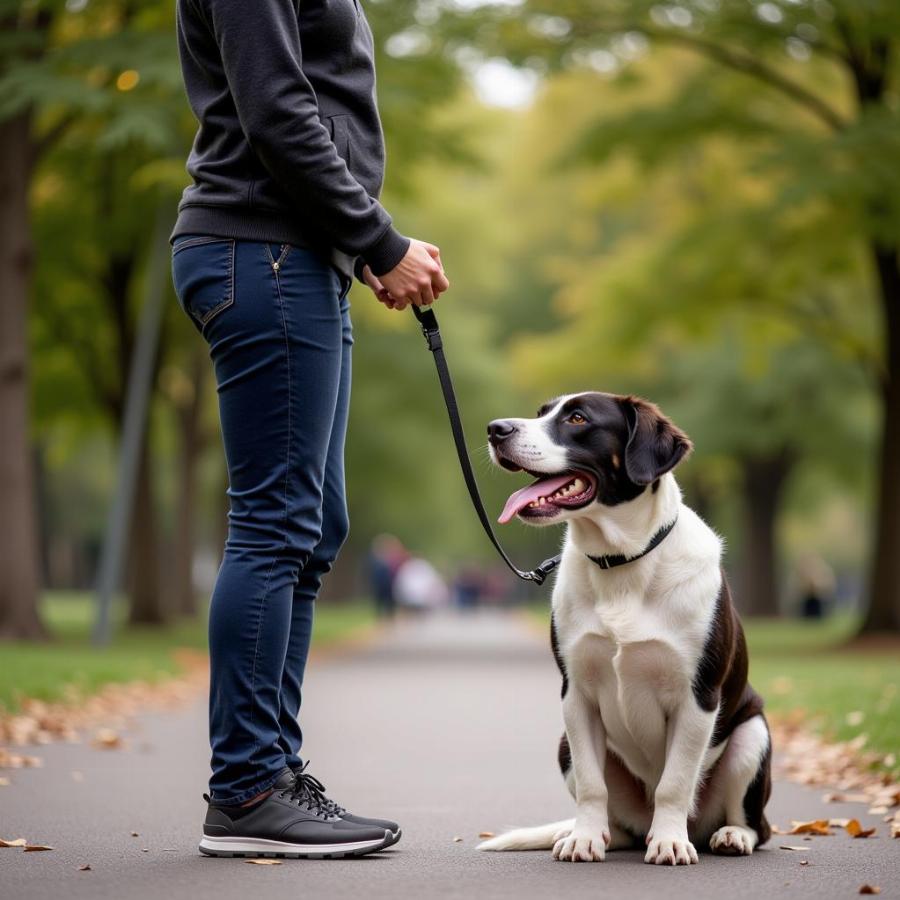Understanding how to establish leadership with your dog isn’t about dominance, but about building a healthy, respectful relationship based on trust and clear communication. It’s about becoming your dog’s trusted guide, providing them with the structure and consistency they need to thrive. This involves setting clear boundaries, rewarding desired behaviors, and meeting their physical and emotional needs. By focusing on positive reinforcement and understanding canine communication, you can build a strong bond and enjoy a harmonious life together.
Understanding Canine Leadership: It’s Not About Dominance
The old-fashioned idea of “dominance” over a dog is outdated and often harmful. Modern dog training focuses on positive reinforcement, building a bond based on trust and understanding. Dogs aren’t striving to take over your household; they simply want to understand their place within your family structure. This is where establishing leadership comes in – you become the dependable, consistent figure who guides them through life. It’s about setting clear boundaries, providing consistent routines, and communicating effectively with your canine companion. This creates a secure and predictable environment where your dog feels safe and understood.
 Establishing Leadership with Your Dog
Establishing Leadership with Your Dog
Building a Bond Based on Trust and Respect
Leadership starts with trust. You build trust by being consistent, reliable, and predictable. This includes meeting your dog’s basic needs for food, water, exercise, and mental stimulation. Playing with your dog, engaging in training sessions, and providing opportunities for socialization are all vital components of building a strong bond. When your dog trusts you, they are more likely to look to you for guidance and follow your lead.
Positive Reinforcement: The Key to Effective Training
Positive reinforcement is the cornerstone of modern dog training. It involves rewarding desired behaviors, such as sitting, staying, or coming when called, with treats, praise, or toys. This reinforces the behavior, making it more likely to occur again. Avoid using punishment or harsh methods, as these can damage your relationship with your dog and lead to fear or aggression.
Setting Clear Boundaries and Expectations
Dogs thrive on structure and routine. Establishing clear boundaries helps them understand what is expected of them and prevents confusion and anxiety. This could include having designated areas for eating, sleeping, and playing, as well as rules about jumping on furniture or begging at the table. Consistency is key – enforce the rules consistently and fairly.
Consistent Routines: Creating Predictability for Your Dog
Dogs are creatures of habit and benefit from predictable routines. Feeding, walking, and training at the same time each day creates a sense of stability and reduces anxiety. This predictability helps your dog feel secure and understood, making them more receptive to your guidance.
Communicating Effectively with Your Canine Companion
Understanding canine body language is crucial for establishing effective communication. Learn to recognize signs of stress, fear, or excitement in your dog. This will help you adjust your approach and avoid situations that may trigger unwanted behaviors. Using clear and consistent verbal cues also helps your dog understand what you are asking of them.
Conclusion
Establishing leadership with your dog isn’t about dominance, but about building a strong, healthy relationship based on mutual trust and respect. By providing clear boundaries, consistent routines, and positive reinforcement, you can become your dog’s trusted guide and enjoy a fulfilling partnership. Remember, patience, consistency, and understanding are key to success.
FAQ
-
What if my dog ignores my commands? Consistency and positive reinforcement are key. Ensure your dog understands the command and reward them immediately when they obey. If the problem persists, consult a professional dog trainer.
-
Is it ever too late to establish leadership with my dog? No, it’s never too late. You can start implementing these principles at any age.
-
How can I tell if my dog trusts me? A trusting dog will maintain eye contact, approach you willingly, and respond positively to your touch and voice.
-
What are some common mistakes people make when trying to establish leadership? Using punishment or harsh methods can damage your relationship with your dog. Inconsistency is another common mistake.
-
How do I deal with a dog that resource guards? Consult a professional dog trainer or behaviorist for guidance on addressing resource guarding. This requires specialized techniques and should be handled carefully.
More Questions?
Check out these related articles on Beaut Dogs:
Beaut Dogs: Your Ultimate Resource for Canine Care
Beaut Dogs is your go-to source for all things dog-related. We offer expert advice and guidance on everything from choosing the right breed to providing the best possible care for your furry friend. For personalized support, contact us at Email: [email protected]. We’re here to help you and your dog live a happy, healthy life together. Visit https://beautdogs.com today to learn more!